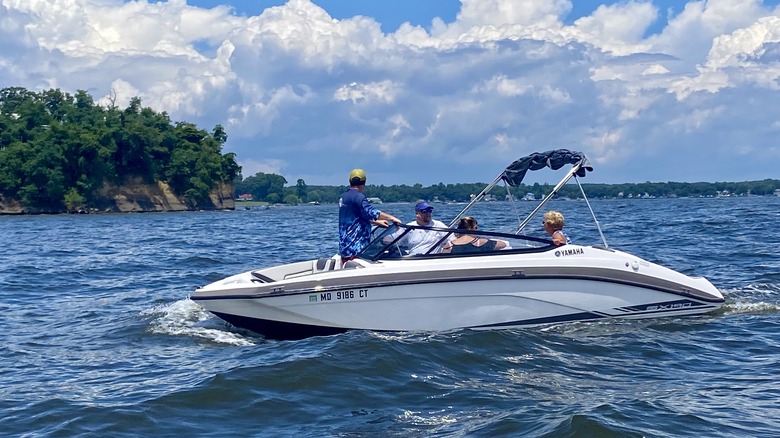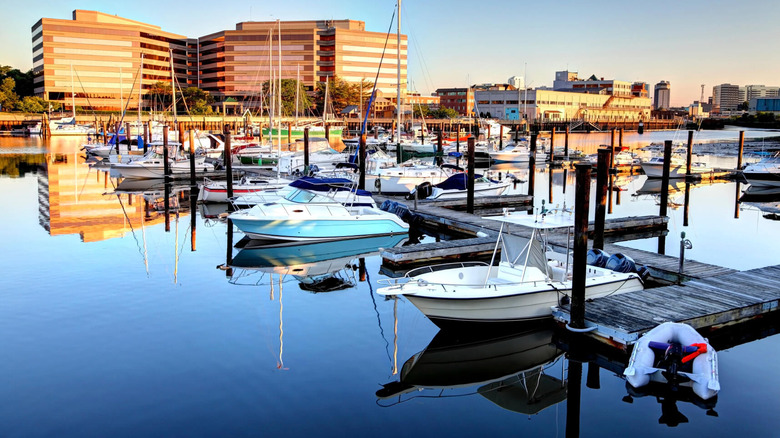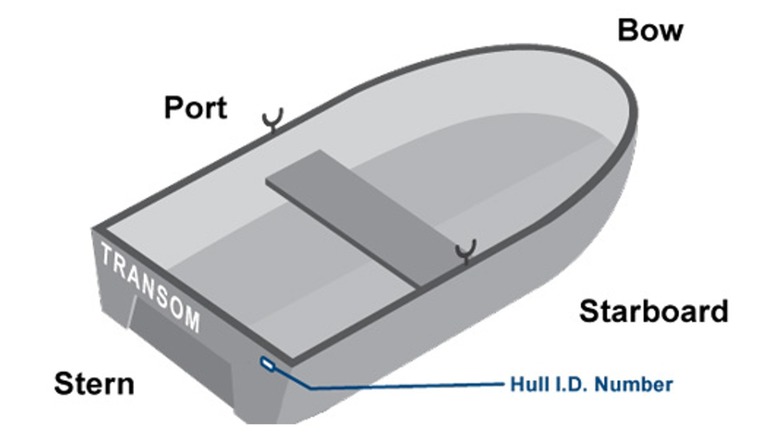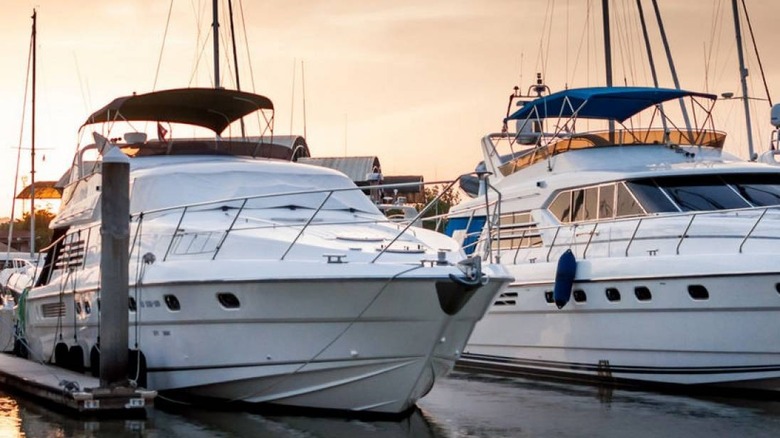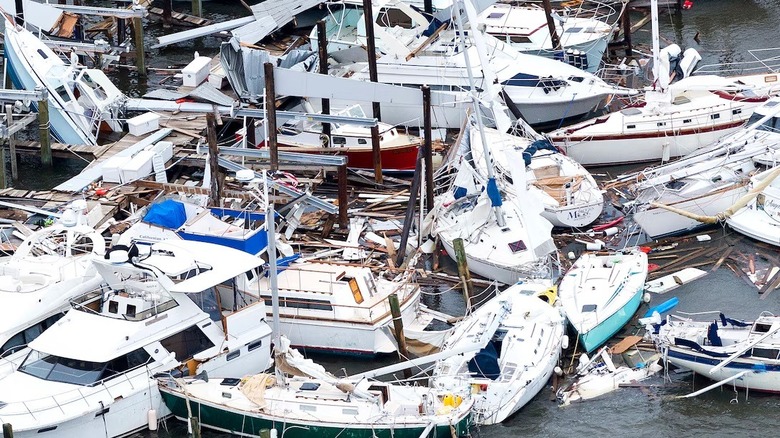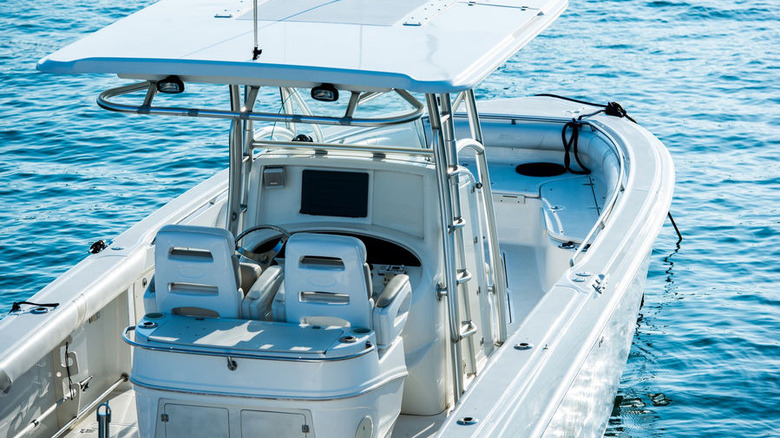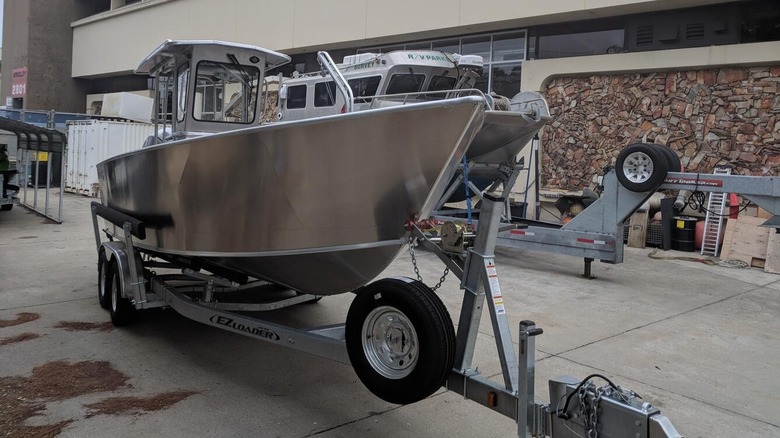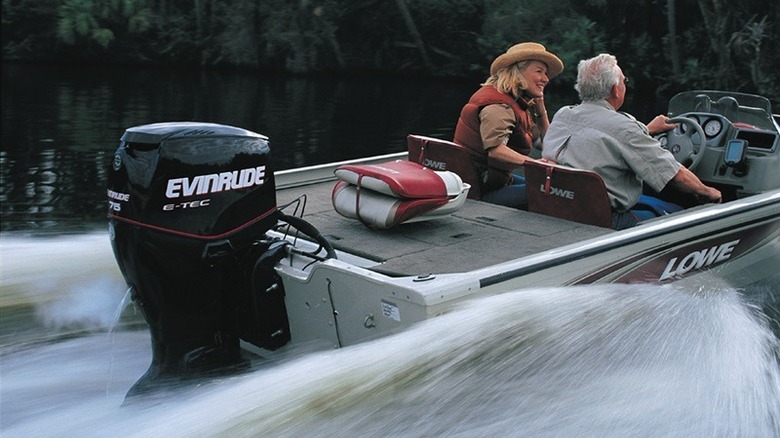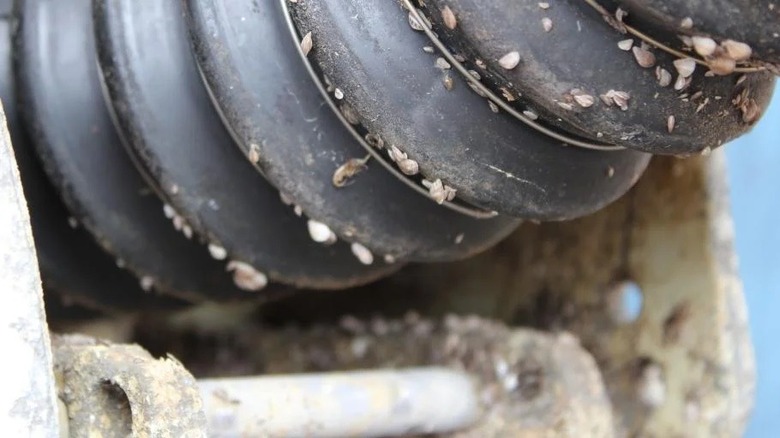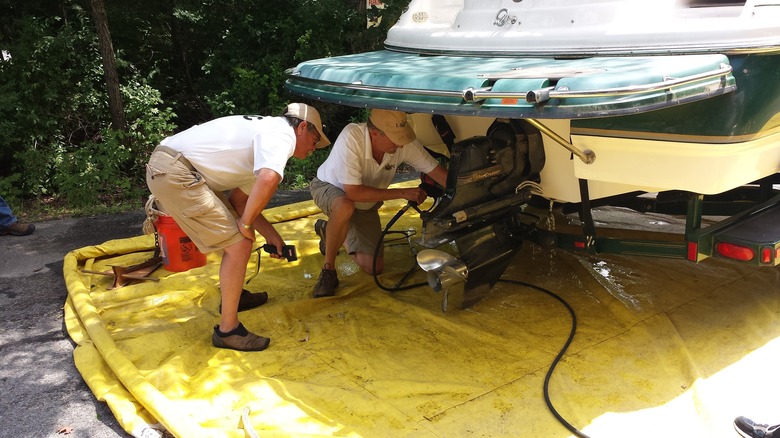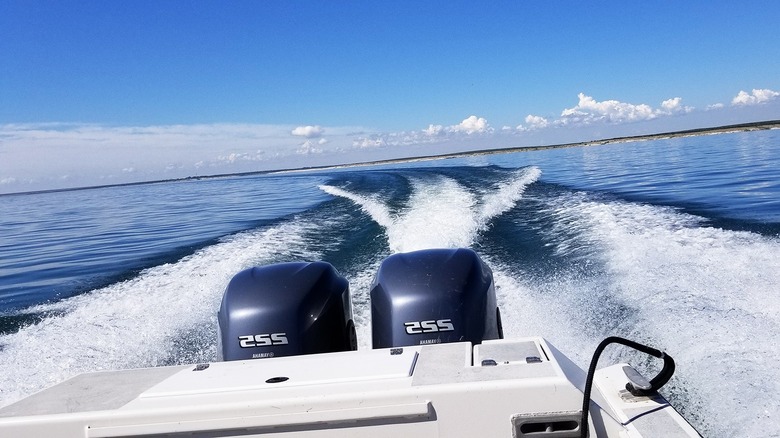10 Things You Should Look Out For When Buying A Used Boat
You've probably considered buying a boat if you live within driving distance of an ocean, lake, reservoir, river, or other large waterway. A boat can be your ticket to endless summertime water skiing, tubing, fishing, and leisurely cruises on calm waters, but they are also a big responsibility. Making an informed decision can be the difference between buyer's remorse and smooth sailing.
For many people, owning a boat is a lifelong goal and a symbol of comfort and success, largely because they are expensive. Boat ownership comes with a hefty initial investment, which varies widely depending on the sort of boat you want. Class A boats (anything under 16 feet) like small fishing canoes can be found for under a thousand dollars, while larger motor boats and yachts sell for thousands or millions of dollars.
When most folks go boat hunting, they usually look for something between those two extremes. A Class 1 (between 16 and 26 feet) or Class 2 (26 to 40 feet) boat fresh off the factory floor will set you back between $50,000 and $150,000. You can get the same boat used for as little as a quarter of the cost, but used boats come with risks. Follow these recommendations to ensure your new boat doesn't become a sunken investment.
Finding the right boat for you
It can be tempting to snatch up the first boat that looks seaworthy and fits your budget, especially if you've wanted a boat for a long time, but it's important to make sure you're not settling for the first thing that floats.
Each boat has its own set of benefits and limitations. Some are good for high-speed sports like water skiing, wakeboarding, or tubing, while others are good for fishing or leisurely cruises across the water. Before you head to the marina to make a purchase, ask yourself what sort of boat you really need. Will you be using your boat primarily in freshwater or saltwater? Are you planning to fish? If so, does your potential boat have a place to hold poles or any other fishing gadgets? Will you go on day trips or spend several days at sea, including overnights? How many passengers do you want to take with you? What means of propulsion do you want or need?
The answers to these questions should narrow down your search and inform your hunt for the perfect boat. The Boat Finder tool from Discover Boating is a good first step in figuring out the kind of boat you really want. You're better off spending a few extra weeks or months finding the right vessel than settling for the quickest or most convenient option.
Common unexpected costs
Boats aren't cheap, and you've probably made your peace with that, but you may not have considered all the additional costs of boat ownership. Even after you've traded your hard-earned cash for a set of keys, there are still plenty of bills to pay.
Make sure your budget accounts for registration with your local authorities, sales tax if applicable in your region, and insurance. Depending on your situation, other cost considerations may include docking during the sailing season and storage over the winter. You'll also need to acquire safety equipment like life preservers, complete education courses, and get a boating license before you can safely and legally hit the water. If you're transporting your boat back and forth from your home, you'll also need a trailer and the ability to tow it, which might require upgrading your vehicle.
Annual service costs can easily run a few thousand dollars in maintenance and repairs, not to mention the ongoing cost of fuel. If terrestrial vehicles are your only barometer, you might be surprised at boats' comparatively low fuel efficiency. When accounting for the higher drag of the water, an average 25-foot boat gets a little better than three miles per gallon while cruising. You can easily burn through dozens or hundreds of gallons over a day at sea.
A damaged transom
Each boat has a transom, which makes up most of the boat's stern. The transom serves as the rearmost wall of a boat and supports the motor. They are typically made of treated wood, reinforced fiberglass, or aluminum and are designed to withstand incredible force.
Transoms have to be strong and durable both to serve as structural support for the aft part of the boat and to endure the force of the attached motor when in use or when being lifted out of the water. Though designed to last, they aren't invincible. Impact forces, contact with the water, and ordinary wear and tear can lead to degradation.
It's crucial to identify any cracks, holes, or other signs of damage to the transom and repair them. Keep an eye out for discoloration or softening caused by water intrusion. If the outer material cracks and water seeps in, it can cause the interior core to rot, causing even bigger problems down the line. If damaged, the transom will need to be reinforced, repaired or replaced. Finding a damaged transom (or any other damage) might be a reason to back out of a sale or it might be an opportunity to negotiate on the price.
Check for any weird smells
Any trip to the marina is bound to be ripe with intense aromas. Nestled beneath the overwhelming smell of saltwater, fish, and seaweed drying on the shore, you might notice some subtle scents from the boat. Some of those smells could reveal potentially catastrophic problems.
Before buying your new used boat, spend some time poking your head into its nooks and crannies and taking a big whiff. Look for any unusual smells, including fuel or mold and mildew. Gasoline smells could indicate a potentially dangerous fuel leak necessitating repairs. Mildew could suggest water has made an invasion into the interior of your boat.
Smelling fuel or mildew won't necessarily tell you the severity of any damage, but a sniff test can point you toward a more thorough investigation. Making a large purchase can be overwhelming, so remember to trust your senses and walk away from a deal (or a boat) that just doesn't smell right.
Look for hull damage
The hull of a boat is its exterior surface, making it one of the easiest things to inspect before buying. Carefully look over the boat's entire exterior surface, preferably from different angles and in variable lighting. Bringing a flashlight or polarizing sunglasses may help to provide different perspectives.
You may want to request that the boat be out of the water, so you can inspect as much of the hull as possible. You'll want to pay special attention to areas that are typically below the waterline. Look for uneven parts of the surface, bumps, waves, or other inconsistencies in the finish. These could indicate damage or previous repairs. If you find hull damage, look at the same spots inside the boat to ensure damage didn't make its way into the interior.
If you see repairs, make sure they aren't hiding any structural damage beneath them. You'll also want to check any fittings that go through the hull, as they are common failure points. Sun exposure can cause plastic fittings to degrade and fail, allowing water to sneak in. If you find damage, make sure to account for the repair in your budget or request to make the purchase contingent on a professional assessment and repair.
Hit the deck (and look for damage)
Boats are large, semi-rigid crafts that take a lot of impact force.Even when piloted cautiously, your boat smashes into the water's surface at high speed. They are designed to be watertight, but ordinary wear and tear can cause problems over time. If the deck is damaged, it won't protect your boat's interior from all the water splashing over the guard rails.
Over time, seals break down and separate, allowing water to leak through. You'll want to inspect where hardware penetrates the deck and where two pieces of material (wood, aluminum, fiberglass) meet. Basically, you're looking for the weak points to ensure there aren't any dents, holes, cracks, delamination, soft spots, or decay. Look for cracks in the gel coating, which may be a concern depending on their location, orientation, and depth.
Finally, don't forget to check out the deck upholstery. Chairs and cushions are easily forgotten but potentially expensive to repair or replace. Even a boat that's otherwise in good shape could incur additional costs if the upholstery is wrecked.
Don't forget the trailer
The best boat in the world is useless if you can't get it into the water. Often, a used boat will come with its trailer, but you may need to buy one separately. In either case, there are a number of important considerations when it comes to a boat trailer.
Getting a boat trailer means you can store your boat at home or in a designated lot instead of paying for marina space. The first consideration is whether a given trailer can bear the weight of your boat. There should be a sticker or metal placard that designates the trailer's weight limit. Those are hard limits and should be taken seriously. The last thing you want is for your trailer to fail while you're cruising down the highway.
Check out the wheels and look for excessive wear on the tires and problems with the wheel bearings. These are relatively affordable repairs but potentially catastrophic if they fail. Depending on the type of trailer, it may not have an active braking system. If it has a braking system, you'll want to ensure it's working correctly. Trailer braking systems work in sync with the braking system of the towing vehicle, so to test them, you'll need to lift the trailer, spin the wheels, and hit the brakes to see if they engage. Lastly, pull out the winch (responsible for pulling your boat out of the water) and look for cracks or fraying.
Look for signs of engine problems
The engine is obviously one of the most important parts of your boat. Failure to operate correctly could ruin your weekend plans or leave you stranded on the water. Before buying a used boat, check the engine for signs of excess damage or wear, and take the motor on a land-based test run.
The first question is of engine type. Do you want an inboard or outboard motor? Inboard motors are more permanently attached to the boat, while outboard motors are attached to the transom and usually cost a little more but have better fuel efficiency and are easier to service. Stern drives are a sort of hybrid system that employs an inboard motor and a second steerable unit attached to the stern.
Ask the owner to fire it up and watch how the motor runs. When testing on dry land, you may notice that the engine initially runs a little rough. That's because it was designed for use in the water and isn't getting the back pressure it's expecting. After a few minutes, it should mellow out and run more smoothly. Check the engine for signs of corrosion and, if it was used in the ocean, evidence of salt build-up. Also, check hoses and belts for cracks and holes. Finally, inspect the engine cowl which, protects the motor and wiring from wind and water.
Check for damage to the bellows
If your prospective used boat uses a stern drive, you'll want to inspect the bellows for signs of damage. The bellows are flexible accordion-shaped gaskets between the motor and interior components. They are important because boat motors use open cooling systems which dump heat into the environment. It's an efficient way to eliminate heat, but it exposes some sensitive engine components. The bellows act as a shield to protect those components from wind, water, and animals. Boat bellows are often treated with pesticides to prevent fish and other critters from chewing through them.
When working correctly, the bellows create an airtight seal to protect the engine's lower drive, exhaust, U-joint, and shift cable. If the bellows are damaged, water can leak in, leading to problems when shifting, engine noise, and water in the cabin. In severe cases, a broken bellows can even sink your boat.
Before buying a boat, inspect the bellows for any cracks or other signs of wear. Check out the internal joints for signs of rust, as that indicates water has crept in previously. If the damage is too severe, you'll want to repair or replace damaged bellows before you get in the water or walk away from a sale.
Find a Marine Surveyor
Once you've found a boat you're fairly certain about, you'll want to have a marine survey completed. Marine surveyors are impartial professionals contracted to inspect a boat and produce a report of any issues. Many lenders and insurance companies won't give you a loan or insurance coverage without a survey documenting the details of a vessel. More importantly, the trained eye of a surveyor may find issues you otherwise would have missed.
There are several different types of marine surveys, including damage and appraisal surveys, but you're most interested in a pre-purchase survey. The surveyor will test all operational components of your boat and should even take it out for a spin to see how it performs on the water. Afterward, the surveyor will outline the vessel's condition and value, confirm identifying markings and registrations, document the official dimensions, and provide a list of any needed repairs.
The costs of a marine survey will vary from place to play but you can expect an average cost of between $20 and $25 per foot. So, a 25-foot boat should run you between $500 and $625. It's a moderate expense, but the information you gain will inform you whether or not you will take the plunge, potentially saving you thousands of dollars down the line.
Perform a sea trial
It's tough to know how a boat will perform until you take it out for a spin. Work with the seller to schedule a sea trial to test drive your boat in its intended environment.
Choose the same or similar body of water as the one you intend to use your boat on. For instance, don't trial it on a lake if you're planning to cruise the ocean. Likewise, you want to use the boat the way you intend to use it in the future. If you're planning to race, then put the boat through its paces during the trial. Run the boat at different speeds, maneuver it from side to side, and pay attention to how it performs. Does it get up to speed like it should? Does it maneuver smoothly? How does it perform on calm water versus choppy? Are there any weird sounds or does anything feel off?
In addition to those operational considerations, you should also pay attention to how you feel at the helm. The sea trial is a chance to get a feel for the boat. What are your sightlines, and are you comfortable in the chair? Spend some time as a passenger as well, to see what the boat will be like for family, friends, and guests. Inspections provide data, but sea trials give you vibes, and when you're buying a boat, that can make all the difference.

